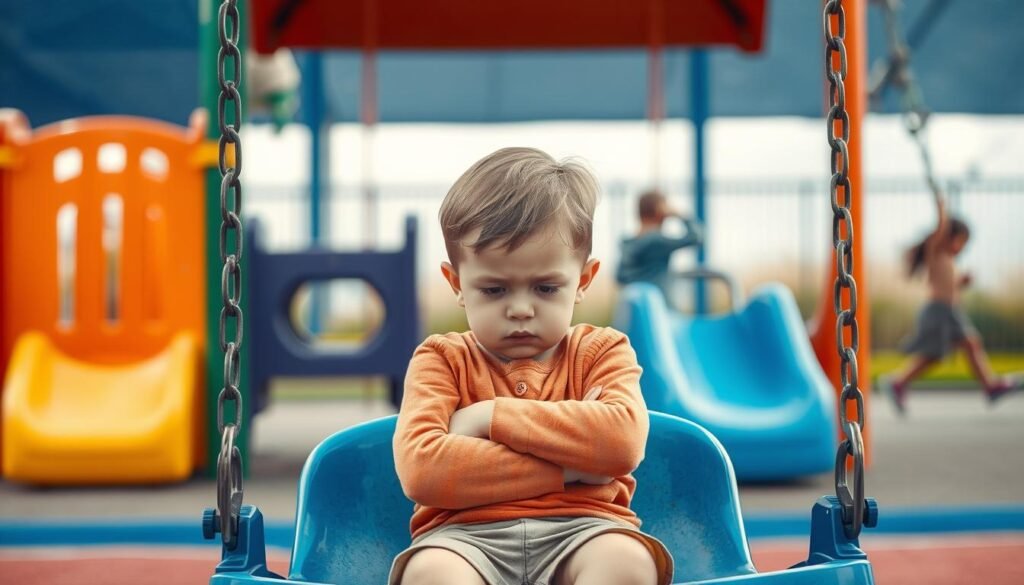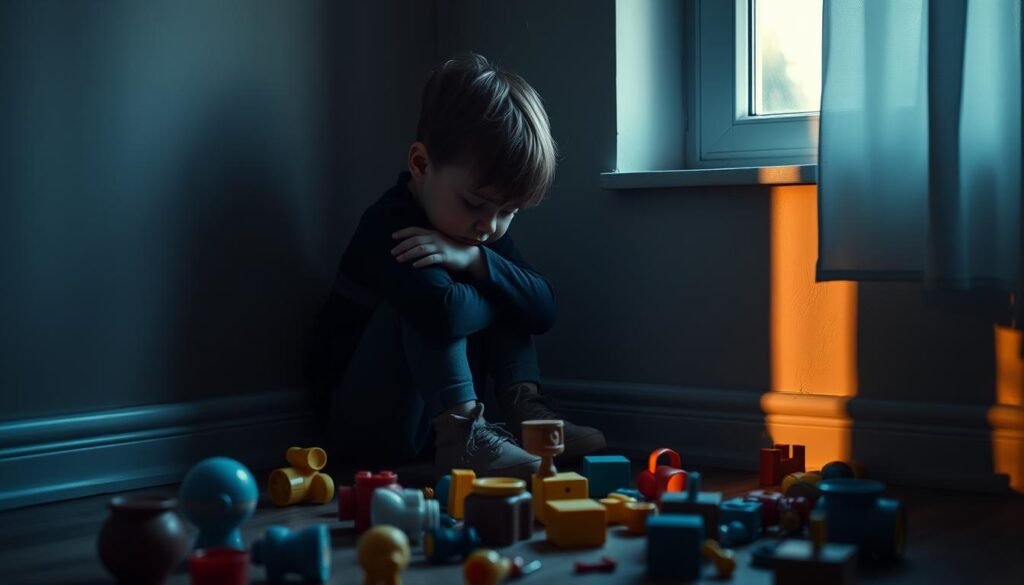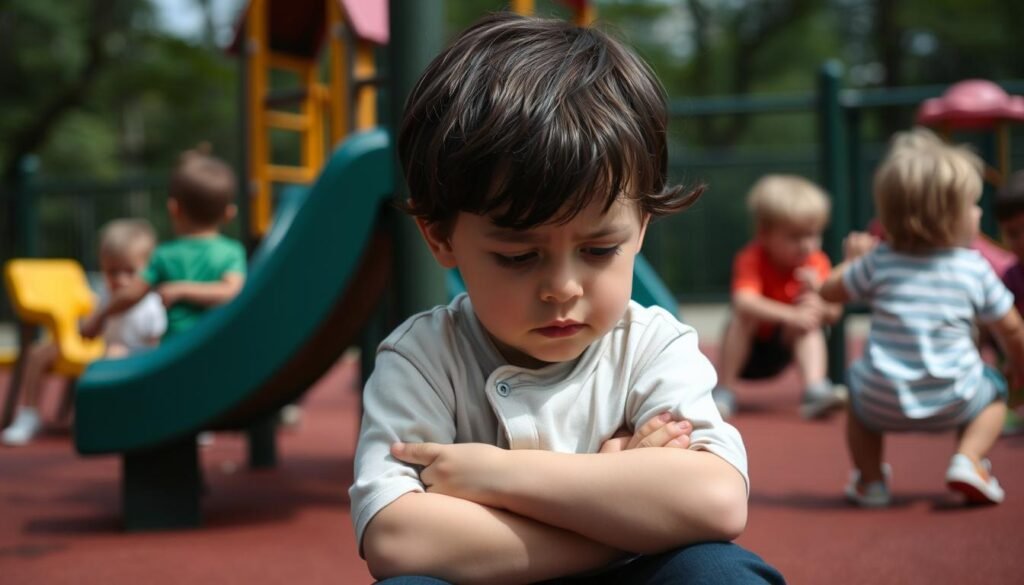Did you know that suicide is a big issue among young ones? For children ages 10-14, it’s the second top cause of death. This fact highlights why it’s crucial to catch anxiety symptoms early in kids. In America, experts recommend checking kids aged 8 to 18 for anxiety. This helps because anxiety in kids doesn’t look the same as in adults. Signs like being easily angered, stomachaches, or changes in how much they eat or sleep might be missed. Without noticing these early signs, children’s anxiety could get a lot worse.
Watching out for how anxiety shows up in kids is a big way caregivers can help. Noticing things like too much worry or not wanting to be around others is key. Seeing these signs early means kids can get the right help sooner. This help can make managing anxiety easier. It gives kids the means to do well in life.
Key Takeaways
- Recognizing early symptoms of anxiety in children is vital for effective intervention.
- Understanding childhood anxiety signs can prevent escalation into serious issues.
- Healthcare professionals, including pediatricians, are critical in identifying anxiety.
- Anxious behaviors, like social withdrawal or physical complaints, should not be overlooked.
- Screening for anxiety is recommended for children aged 8 to 18 to ensure mental well-being.
Understanding Anxiety in Children
Anxiety in children often begins as a normal reaction to stress. It shows up in different ways. This reaction is okay when it’s about specific situations, but it’s a problem when it turns into widespread anxiety disorder symptoms kids face for a long time. It’s vital for parents and caregivers to recognize the signs of anxiety in children. This is because kids might not be able to share how they feel.
As children grow, their fears can change. Young kids, from 6 months to 3 years old, often fear being away from their parents. This is called separation anxiety. In preschool, fears of animals, storms, and the dark are common but usually fade as they get older. Then, older kids may face anxiety about school, social situations, or changes in their lives. This anxiety can stop them from doing activities they used to enjoy.
It’s key to watch for symptoms of anxiety. Look out for signs like being irritable, clingy, having trouble sleeping, stomachaches, and nightmares. These can point to deeper anxiety issues. As kids become teenagers, social anxiety can become stronger. Many might start avoiding hanging out with others.
Many things can cause anxiety in children. These include traumatic events, family problems, and stress at school. A large number, about 32% of adolescents in the U.S., suffer from some anxiety disorder. This shows how serious the issue is.
It helps to make a home where kids feel they can talk about their worries. Setting routines and learning coping methods can help a lot. Parents can teach kids to notice when they’re feeling anxious and find ways to deal with it. Using a “worry” box or doing relaxation exercises can also help kids manage their anxiety.
Common Childhood Anxiety Signs
It’s vital to spot signs of anxiety in kids early. Knowing the signs of anxiety in young children helps get them the right support. Many kids worry a lot about things like school or meeting new people. They may struggle to focus or feel too anxious, which affects their everyday life.
Kids with anxiety often have physical signs like a fast heartbeat or stomach issues. They may not want to join in with friends, avoid school, or stick close to their parents. These behaviors are key clues that a child might need help. For more information, take a look here.
The following table outlines various anxiety disorders and their associated signs:
| Anxiety Disorder | Common Signs |
|---|---|
| Generalized Anxiety Disorder (GAD) | Chronic worry about various aspects of life, difficulty focusing, sleep disturbances. |
| Separation Anxiety Disorder | Intense fear of being away from parents, missing school, or avoiding activities without parental presence. |
| Social Anxiety Disorder | Extreme fear of social interactions, physical symptoms like sweating or blushing. |
| Panic Disorder | Sudden panic attacks with symptoms such as shortness of breath and trembling. |
| Selective Mutism | Refusal to speak in specific social settings despite normal speech ability at home. |
| Specific Phobias | Intense fear of particular situations or objects leading to avoidance behavior. |

Early recognition of these signs can change a child’s life. Interventions like therapy, and sometimes medication, teach coping strategies. Knowing these childhood anxiety red flags helps parents support their children effectively.
Symptoms of Anxiety in Children
It’s key for parents and caregivers to know the symptoms of anxiety in kids. These symptoms can be emotional, physical, or behavioral. Spotting them can help support and assist the child effectively.
Emotional Indicators
Emotional symptoms show up through how kids act when anxious. They might feel scared, panicked, or embarrassed often. Worrying about different things or thinking negatively can hurt their emotional health. It’s important for parents to notice any emotional shifts. This could signal the start of serious anxiety issues.
Physical Signs
Physical symptoms can clue us into a child’s anxiety too. Kids may not sleep well, complain about stomachaches, feel tired, or be unable to sit still. These signs often pop up on Sunday nights or Monday mornings due to school worries. Observing these physical signs is crucial for fully understanding a child’s anxiety.
Behavioral Changes
When kids are anxious, their behavior might change a lot. They can become irritable, have sudden mood changes, or stop liking activities they once enjoyed. These behavioral shifts could mean the kid is dealing with anxiety. Identifying these signs early can lead to helpful support and ways to cope.

| Type of Symptoms | Examples |
|---|---|
| Emotional Indicators | Fear, panic, negative thoughts |
| Physical Signs | Insomnia, stomachaches, fatigue |
| Behavioral Changes | Irritability, mood swings, withdrawal |
Recognizing Anxious Behaviors in Kids
Anxiety disorders are common in children and lead to various anxious behaviors in kids. These behaviors can be surprising to parents. They appear in situations that other kids find easy. Noticing these signs early can help tackle the symptoms of anxiety in young kids.
Children might struggle with new experiences like starting school or group activities. They may respond with tantrums, tears, or by avoiding social interactions. It’s key to understand that these actions point to deeper issues. Only then can we offer the right support.

It’s crucial to spot the symptoms of anxiety in young kids early. Doing so prevents problems with making friends or doing well in school later on. Experts suggest watching and talking to help kids share their feelings. This approach helps create a caring space where kids feel safe to talk about their fears.
| Common Anxious Behaviors | Possible Underlying Causes |
|---|---|
| Tantrums | Overwhelming fear or frustration |
| Withdrawal | Anxiety about social interactions |
| Physical Complaints (stomachaches, headaches) | Stress response or psychological discomfort |
| Difficulty Sleeping | Racing thoughts or fear of the unknown |
| School Refusal | Fear of performance or separation |
For more details, resources like detecting childhood anxiety offer great insight into identifying and supporting anxious kids.
Signs of Anxiety in Young Children
Anxiety in young children can show up in many ways, affecting their everyday lives. It’s important for parents and caregivers to recognize these signs. This is especially true for situations like being away from caregivers and dealing with school.
Separation Anxiety
Separation anxiety is common in young kids, especially those in preschool. These children may feel very upset when not near their main caregivers. This can even start as early as six months old. Kids may cry a lot, want to stay close to someone they trust, or complain about feeling sick. Without help, separation anxiety might not go away, even as they grow. Things like a big move or losing a loved one can make it worse.
School-Based Anxiety
When kids get older, their anxiety might focus more on school. Watch for signs like not wanting to go to school, saying they feel sick, or getting upset in the mornings. These problems can come from worries about grades, being bullied, or starting at a new school. Solving these issues quickly is key to helping a child feel better and do well with friends and in class.
| Type of Anxiety | Common Signs | Possible Impact |
|---|---|---|
| Separation Anxiety | Clinginess, crying, complaints before separation | Difficulty transitioning to school, distress in social settings |
| School-Based Anxiety | Reluctance to attend, stomach pains, emotional outbursts | Impeded social and academic development |
Knowing about these anxiety signs helps parents act early. This way, kids get the support they need to feel emotionally healthy.
Long-Term Effects of Childhood Anxiety
About 8% of kids and teenagers in the US deal with anxiety disorders. These issues can hurt their social life and schoolwork. If not helped, these problems might get worse as they grow.
Children with ongoing anxiety may struggle with friendships, school, and feelings. They could face depression or start using substances in their teen years. Finding and treating these problems early is key. Treatments like CBT can change negative thoughts and help kids handle their anxiety.
Things like trauma, family problems, or conditions like ADHD and autism can make anxiety worse. Kids dealing with these may need extra support from services like CYPMHS. These programs help them overcome anxiety.
Studies show treatments like CBT really help with anxiety symptoms. Over 80% of kids getting help feel better in just 12 weeks. It’s crucial to deal with childhood anxiety early to avoid bigger issues later.
It’s important to know how childhood anxiety can affect the future. Support from family can help kids face their fears and grow emotionally. For more info on dealing with anxiety, check out this guide on fear and anxiety and how to recognize anxiety.
| Impact Area | Potential Issues | Recommended Treatments |
|---|---|---|
| Social Development | Difficulty in forming friendships | Cognitive Behavioral Therapy (CBT) |
| Academic Performance | Poor concentration and motivation | Therapeutic interventions |
| Emotional Health | Risks of depression and substance abuse | Medication and counseling |
| Family Relations | Increased stress and conflict | Family therapy sessions |
| Future Functioning | Employment and life satisfaction | Support groups and ongoing therapy |
When to Seek Professional Help
Knowing when to seek help for your child’s anxiety is crucial. Some kids get anxious now and then. But if it gets severe or won’t go away, it could mean something more serious. Look out for signs like constant tummy aches, headaches, tantrums, or trouble sleeping. These could point to anxiety.
Anxiety can come from many places. Trouble at school, bullying, family stress, or seeing something traumatic can all raise anxiety levels. If your child starts avoiding things they usually do or seems moodier, it might be time to see a professional. This includes doctors, counselors, and psychologists who know how to help.
There are good resources out there for kids who feel anxious. Programs like The Brave Program and the Cool Kids Program help kids aged 7-12 tackle their fears and get confident. The Fear-Less Triple P Online Course gives them tools to cope with anxiety and be emotionally strong. For quick help, Kids Help Line offers private counseling any time.
Start with talking openly with your child about anxiety. Help them face what scares them little by little and find ways to cope. Setting up a regular routine can also ease the stress anxiety brings.
Here’s a quick look at some resources and services for anxious children:
| Resource | Description |
|---|---|
| The Brave Program | Interactive program for 8-12 year-olds for overcoming worries. |
| Cool Kids Program | Online program assisting 7-12 year-olds in building confidence. |
| Fear-Less Triple P Online Course | Toolkit for children to manage anxiety and enhance resilience. |
| Kids Help Line | Free 24/7 online and phone counseling for youngsters. |
| Smiling Mind Kids Care Packages | Provides calming activities and mindfulness meditation recordings. |
| Parentline | Supportive phone counseling for parenting challenges. |
Supporting Your Anxious Child at Home
Helping anxious kids at home is about making them feel safe and understood. Parents should use good communication to support their child’s emotions. It’s crucial to know how to deal with their anxious behaviors.
Communication Strategies
It’s key to have open talks. Letting kids share their feelings without fear helps them get their emotions straight. Here are some tips for talking with anxious children:
- Use calm and supportive language.
- Ask open-ended questions to encourage them to open up.
- Avoid questions that might make their anxiety worse.
- Make sure they know their feelings are valid.
- Show them you believe they can overcome their fears in time.
Creating a Supportive Environment
Making a calm home is vital for easing anxiety. Here are important steps to create such an environment:
- Keep a regular routine to give them stability.
- Promote daily exercise for at least an hour.
- Make sure they get enough sleep for their well-being.
- Limit scary media and push for outdoor play.
- Show them how to deal with stress in healthy ways.
By focusing on communication and creating a supportive setting, parents can truly help anxious children. Being patient and promoting strength lets families lower anxiety in their kids over time.
Conclusion
It’s important to recognize childhood anxiety early. About one in eight kids are affected. Knowing the signs of anxiety in children can help spot and treat it. Anxiety comes in forms like Generalized Anxiety Disorder and Social Anxiety Disorder. These can look like normal kid behavior but are more serious.
Talking openly with kids lets them share their feelings safely. Catching anxiety signs early can really help a child’s life. Parents should watch for things that stress their kids out, both at home and school.
Creating a supportive home is key as kids grow. It helps them deal with their anxieties. By knowing how important it is to recognize anxiety, we can help kids emotionally. For tips on spotting anxiety signs in kids, check out this article.